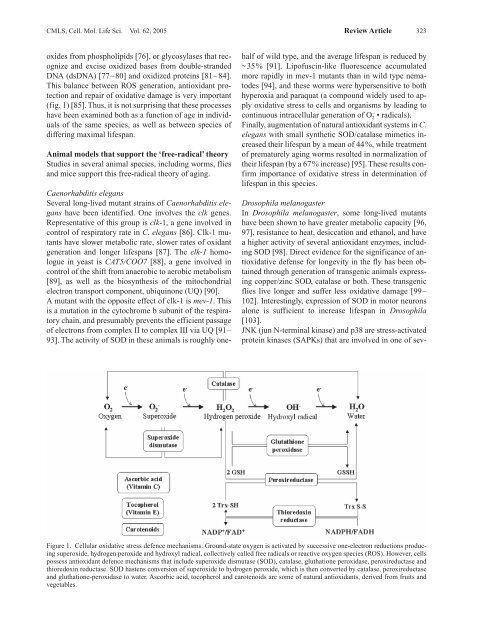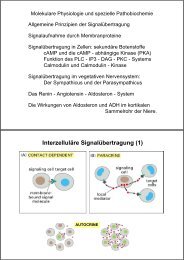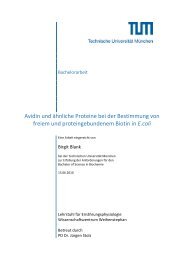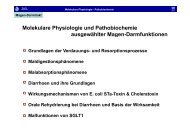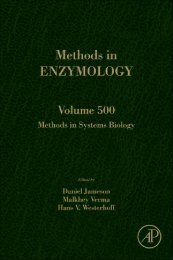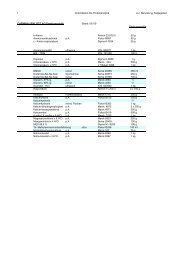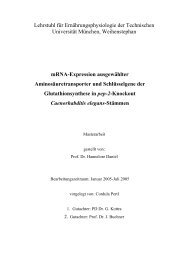Review The role of insulin and IGF-1 signaling in longevity
Review The role of insulin and IGF-1 signaling in longevity
Review The role of insulin and IGF-1 signaling in longevity
Create successful ePaper yourself
Turn your PDF publications into a flip-book with our unique Google optimized e-Paper software.
CMLS, Cell. Mol. Life Sci. Vol. 62, 2005 <strong>Review</strong> Article 323<br />
oxides from phospholipids [76], or glycosylases that recognize<br />
<strong>and</strong> excise oxidized bases from double-str<strong>and</strong>ed<br />
DNA (dsDNA) [77–80] <strong>and</strong> oxidized prote<strong>in</strong>s [81–84].<br />
This balance between ROS generation, antioxidant protection<br />
<strong>and</strong> repair <strong>of</strong> oxidative damage is very important<br />
(fig. 1) [85]. Thus, it is not surpris<strong>in</strong>g that these processes<br />
have been exam<strong>in</strong>ed both as a function <strong>of</strong> age <strong>in</strong> <strong>in</strong>dividuals<br />
<strong>of</strong> the same species, as well as between species <strong>of</strong><br />
differ<strong>in</strong>g maximal lifespan.<br />
Animal models that support the ‘free-radical’ theory<br />
Studies <strong>in</strong> several animal species, <strong>in</strong>clud<strong>in</strong>g worms, flies<br />
<strong>and</strong> mice support this free-radical theory <strong>of</strong> ag<strong>in</strong>g.<br />
Caenorhabditis elegans<br />
Several long-lived mutant stra<strong>in</strong>s <strong>of</strong> Caenorhabditis elegans<br />
have been identified. One <strong>in</strong>volves the clk genes.<br />
Representative <strong>of</strong> this group is clk-1, a gene <strong>in</strong>volved <strong>in</strong><br />
control <strong>of</strong> respiratory rate <strong>in</strong> C. elegans [86]. Clk-1 mutants<br />
have slower metabolic rate, slower rates <strong>of</strong> oxidant<br />
generation <strong>and</strong> longer lifespans [87]. <strong>The</strong> clk-1 homologue<br />
<strong>in</strong> yeast is CAT5/COO7 [88], a gene <strong>in</strong>volved <strong>in</strong><br />
control <strong>of</strong> the shift from anaerobic to aerobic metabolism<br />
[89], as well as the biosynthesis <strong>of</strong> the mitochondrial<br />
electron transport component, ubiqu<strong>in</strong>one (UQ) [90].<br />
A mutant with the opposite effect <strong>of</strong> clk-1 is mev-1. This<br />
is a mutation <strong>in</strong> the cytochrome b subunit <strong>of</strong> the respiratory<br />
cha<strong>in</strong>, <strong>and</strong> presumably prevents the efficient passage<br />
<strong>of</strong> electrons from complex II to complex III via UQ [91–<br />
93]. <strong>The</strong> activity <strong>of</strong> SOD <strong>in</strong> these animals is roughly one-<br />
half <strong>of</strong> wild type, <strong>and</strong> the average lifespan is reduced by<br />
~35% [91]. Lip<strong>of</strong>usc<strong>in</strong>-like fluorescence accumulated<br />
more rapidly <strong>in</strong> mev-1 mutants than <strong>in</strong> wild type nematodes<br />
[94], <strong>and</strong> these worms were hypersensitive to both<br />
hyperoxia <strong>and</strong> paraquat (a compound widely used to apply<br />
oxidative stress to cells <strong>and</strong> organisms by lead<strong>in</strong>g to<br />
cont<strong>in</strong>uous <strong>in</strong>tracellular generation <strong>of</strong> O 2 – • radicals).<br />
F<strong>in</strong>ally, augmentation <strong>of</strong> natural antioxidant systems <strong>in</strong> C.<br />
elegans with small synthetic SOD/catalase mimetics <strong>in</strong>creased<br />
their lifespan by a mean <strong>of</strong> 44%, while treatment<br />
<strong>of</strong> prematurely ag<strong>in</strong>g worms resulted <strong>in</strong> normalization <strong>of</strong><br />
their lifespan (by a 67% <strong>in</strong>crease) [95]. <strong>The</strong>se results confirm<br />
importance <strong>of</strong> oxidative stress <strong>in</strong> determ<strong>in</strong>ation <strong>of</strong><br />
lifespan <strong>in</strong> this species.<br />
Drosophila melanogaster<br />
In Drosophila melanogaster, some long-lived mutants<br />
have been shown to have greater metabolic capacity [96,<br />
97], resistance to heat, desiccation <strong>and</strong> ethanol, <strong>and</strong> have<br />
a higher activity <strong>of</strong> several antioxidant enzymes, <strong>in</strong>clud<strong>in</strong>g<br />
SOD [98]. Direct evidence for the significance <strong>of</strong> antioxidative<br />
defense for <strong>longevity</strong> <strong>in</strong> the fly has been obta<strong>in</strong>ed<br />
through generation <strong>of</strong> transgenic animals express<strong>in</strong>g<br />
copper/z<strong>in</strong>c SOD, catalase or both. <strong>The</strong>se transgenic<br />
flies live longer <strong>and</strong> suffer less oxidative damage [99–<br />
102]. Interest<strong>in</strong>gly, expression <strong>of</strong> SOD <strong>in</strong> motor neurons<br />
alone is sufficient to <strong>in</strong>crease lifespan <strong>in</strong> Drosophila<br />
[103].<br />
JNK (jun N-term<strong>in</strong>al k<strong>in</strong>ase) <strong>and</strong> p38 are stress-activated<br />
prote<strong>in</strong> k<strong>in</strong>ases (SAPKs) that are <strong>in</strong>volved <strong>in</strong> one <strong>of</strong> sev-<br />
Figure 1. Cellular oxidative stress defence mechanisms. Ground-state oxygen is activated by successive one-electron reductions produc<strong>in</strong>g<br />
superoxide, hydrogen peroxide <strong>and</strong> hydroxyl radical, collectively called free radicals or reactive oxygen species (ROS). However, cells<br />
possess antioxidant defence mechanisms that <strong>in</strong>clude superoxide dismutase (SOD), catalase, gluthatione peroxidase, peroxireductase <strong>and</strong><br />
thioredox<strong>in</strong> reductase. SOD hastens conversion <strong>of</strong> superoxide to hydrogen peroxide, which is then converted by catalase, peroxireductase<br />
<strong>and</strong> gluthatione-peroxidase to water. Ascorbic acid, tocopherol <strong>and</strong> carotenoids are some <strong>of</strong> natural antioxidants, derived from fruits <strong>and</strong><br />
vegetables.


